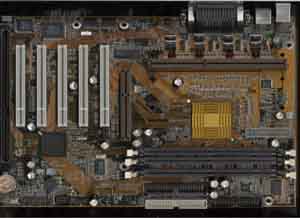Gigabyte GA-7IX Slot-A AMD 750 ATX
by Mike Andrawes on January 22, 2000 1:13 AM EST- Posted in
- Motherboards
Gigabyte has quickly become known in the AnandTech labs for their extremely solid motherboards with moderate overclocking options. Gigabyte has even come up with a few unique innovations, such as their Dual BIOS setup on some boards that prevents a virus or bad BIOS flash from taking down your system. When it was time to make an Athlon motherboard, Gigabyte chose a slightly different route than they normally do.
New Anand Tech Report Card Rating 88/B+
| CPU Interface | Slot-A |
| Chipset | AMD 750 |
| L2 Cache | N/A (on-chip) |
| Form Factor | ATX |
| Bus Speeds | 100 |
| Voltages Supported | Auto Detect |
| Memory Slots | 3 168pin DIMM Slots |
| Expansion Slots | 0 AMR Slots 1 AGP Slot 5 PCI Slots (2 Full Length) 2 ISA Slots (1 Shared / 2 Full Length) |
| BIOS | Award 4.51PG |
The Good
The Gigabyte GA-7IX was one of the first Athlon motherboards to arrive in the AnandTech labs, preceded only by AMD's own Fester reference board. Not surprisingly, the GA-7IX is very closely based on that reference design. The most prominent difference is Gigabyte's use of a 5/2/1 (PCI/ISA/AGP) slot configuration, rather than AMD's dated 4/3/1 setup. The 3 DIMM slots are also a carry over from the AMD design.
Layout of the GA-7IX is also virtually identical to the AMD Fester, which is a good thing. The ATX specification is closely followed with all major connectors strategically placed to minimize cable clutter and provide the most room to work around the board. All HDD/FDD connectors are right at the front of the board, exactly where they should be so that no cables are forced to run over the CPU and/or memory. The ATX power connector is just behind the DIMM slots, which could prevent the use of very large heatsinks, but everything in the AnandTech lab fit just fine.
The front panel connectors may prevent the use of full length cards in 4 of the PCI slots. The HDD connectors are color coded white or black to indicate primary or secondary channels. Along the same lines, the entire back panel I/O features the rainbow of colors that's become standard thanks to the PC99 spec. Gigabyte has also added a header for front panel USB connectors. However, when enabled, the rear ports are disabled.
The GA-7IX uses a voltage regulator setup almost identical to the Fester, with one major cost cutting measure - the Gigabyte does not feature the heatsinks on the voltage regulator chips that were on the AMD. What that means to the user is that stability in high current situations (ie as CPU speed increases) may be compromised as heat builds up on the regulators. Fortunately, we didn't notice any such issues with the latest revision of the board. A testament to this is the fact that the GA-7IX is the motherboard of choice for the Kryotech SuperG, showing it is capable of handling CPU's up to 1GHz. Rather than using one gaint capacitor to provide stable power to the CPU as AMD did, Gigabyte uses a number of 330uF capacitors all over the board, with a 1200uF right next to the Slot-A connector.












0 Comments
View All Comments